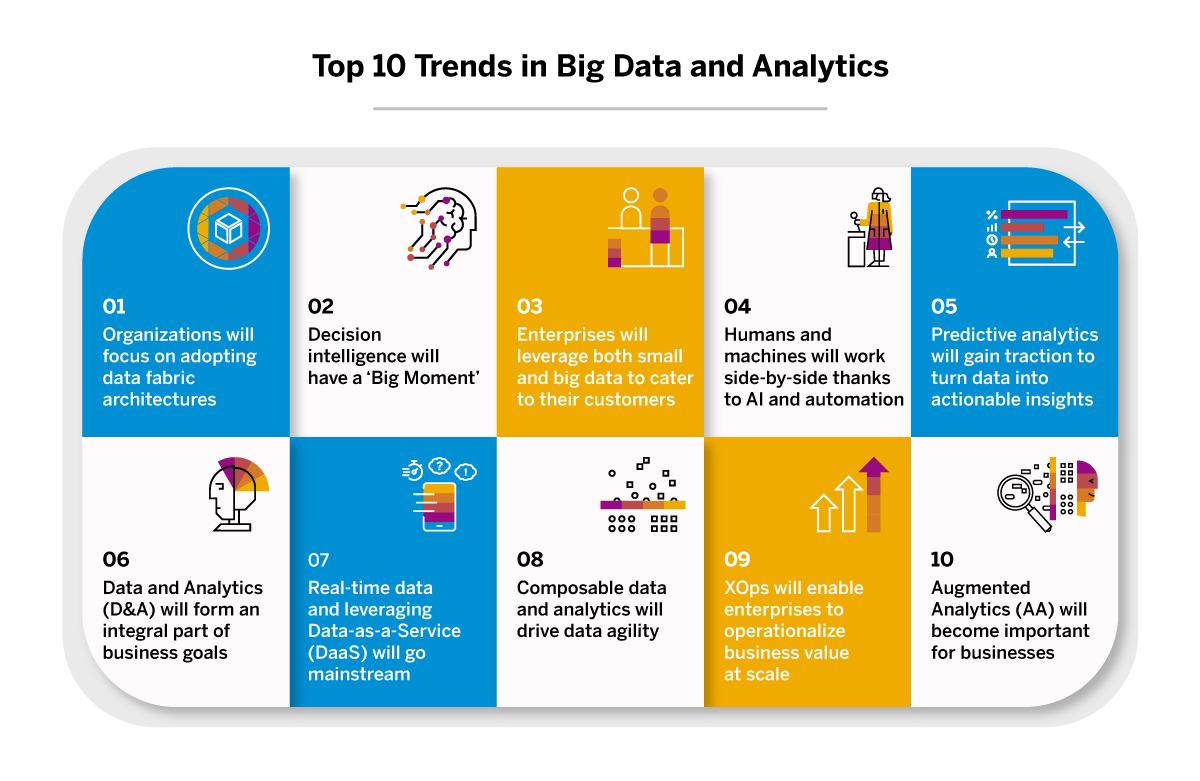The term big data was invented back in the 1990s, but it wasn’t until the turn of the millennium that it really picked up steam. This was when internet and technology companies took the world by storm through the uninhibited transaction of data. But how big is big data? To truly understand the staggering nature of big data, you need to get a bird’s eye view of the amount of data generated by humans. Consider this estimate: We produce 1.145 trillion MB of data per day. In 2021, more than 6,500 million connected devices shared information over the Internet. In 2025, this figure is set to more than double to 20,000 million.
Today, big data has become ubiquitous and has virtually reshaped business and operations across a host of industries such as technology, healthcare, ecommerce, law enforcement, medicine and diagnostics, agriculture, weather forecasts, streaming platforms, wearable devices, and so on. It is no longer about leveraging just data storage, cloud services, and communications. Instead, big data has opened vast opportunities for companies to leverage data, enhance customer service, streamline businesses, and rethink the interconnectedness of everything.
The explosive growth of big data can be attributed to the numerous advantages it provides, such as enabling:
- Better strategic decisions
- Enhanced operational process control
- Better understanding of consumers
- Effective cost reduction
- Increase in revenues
No wonder then the global big data and analytics market is expected to grow at a CAGR of 10% between 2022-2027 to reach USD 450 billion by 2026. Considering this exponential pace of growth of big data, a CIO or CTO will want to keep ahead of these ten trends making waves in the field.

1. Organizations will focus on adopting data fabric architectures
Digital channels are exploding–be it for marketing, sales, customer support, or services. Adding to the complexity is the remote style of working. Enterprises now find themselves grappling with a plethora of applications, devices, and different kinds of data infrastructure (think data warehouse, data lakes). In simpler terms, the distributed enterprise lacks a centralized data infrastructure–one that seamlessly weaves together all the data available and caters to the organization’s data and analytics needs end-to-end.
Enter data fabric architectures. This technology is gaining momentum as it can effectively integrate multiple data repositories across cloud and regional boundaries. Going forward, organizations will need to strategize ways to drive a singular enterprise-wide data and analytics management approach that empowers them and boosts delivery time.
2. Decision intelligence will have a ‘Big Moment’
As more and more data-driven enterprises continue to digitize their business processes to gain a competitive edge, decision intelligence will come into focus. According to estimates by the World Economic Forum, around 463 exabytes of data will be created each day globally by 2025. In absolute terms, this is equivalent to 212,765,957 DVDs a day.All the data generated is of no business value if it cannot be translated into actionable decisions and by extension, outcomes. This is where decision intelligence comes into the big picture.
Since machines cannot understand the implications of decision outcomes, there’s need for human intervention. Enterprises should drive greater collaboration between decision intelligence data scientists and business teams to extract maximum value. When used correctly, decision intelligence can serve as the ‘bridge’ between data and improved decision making. In fact, decision intelligence is going mainstream, with Gartner predicting that “by 2023, more than 33% of large organizations will have analysts practicing decision intelligence, including decision modeling.”
Pro tip: Enterprises need to integrate decision intelligence into their data management strategy and the existing business intelligence stack to measure outcomes–or else, they risk losing their competitive value.
3. Enterprises will leverage both small and big data to cater to the customers
Not all data decisions will be focused solely on big data. There will be increasing emphasis on combining both small data and big data to deliver near-term value and extract strategic benefits in the long-term. For instance, small data analytics can:
- Empower organizations to deliver a hyper-personalized customer experience by using actionable, targeted data to cater to a specific issue or problem that customers might be facing.
- Answer core strategic questions about the business and help understand the best big data applications to use to drive more advanced analytics.
- Help drive data management excellence within an organization as the data becomes more manageable.
Furthermore, it is predicted that by 2025, 80% of all data would be unstructured. With organizations increasingly using unstructured and structured data together, this trend will become a must-have feature for businesses.
4. Humans and machines will work side-by-side
Technologies such as Artificial Intelligence and automation will augment the workforce across industries and sectors to create a digitally-resilient economy. In fact, research by the World Economic Forum states that the robot revolution will create 97 million new jobs by 2025.
While AI offers multiple business benefits such as improved learning algorithms, efficient data processing, predictive analytics for trend forecasting, and more, the role of human resources cannot be undermined. This means that while businesses may have to ramp up their investment to leverage responsible and ‘smarter’ AI, human talent will remain crucial to driving key tasks that machines are unable to perform (yet). These can include informed decision-making, crisis and scenario mapping, spotting anomalies from the data at hand, adapting to adversity, interpersonal skills, and creative thinking.
5. Predictive analytics will Gain Traction
Data is quickly emerging as the world’s most-valuable resource. That said, it is not enough for organizations to amass gigantic proportions of data. They need to be able to transform the data into actionable insights extracted through powerful analytical tools. This is where predictive analysis comes into play.
Think of predictive analysis at the juncture of big data and business intelligence, allowing organizations to:
- Predict future trends with respect to the market, customers, cloud applications, product performance, among others,
- Leverage AI/ML algorithms to improve data-based decisions and business outcomes,
- Conduct predictive marketing and data mining to target customers in a smarter way,
- Eliminate bottlenecks and issues with respect to operational efficiency, and
- Optimize their internal processes and positively impact the bottom line.
Such is the popularity of predictive analysis that the global Predictive Analytics market size is projected to reach USD 35.45 billion by 2027.
6. Data and Analytics (D&A) will form an integral part of business goals
With more and more businesses realizing the powerful value of data, D&A will emerge as a core business function as opposed to a secondary goal, which has long been the case.
This makes business sense as research indicates that companies only end up analyzing 12% of the data they have–the other 88% of data goes unanalyzed. In addition, only 24.4% of companies claim to have forged a data-driven culture, making D&A a top priority among businesses. This becomes even more important when we consider that with big data, organizations can:
- Use data-driven strategies to innovate their offerings
- Predict outcomes more accurately
- Understand how the product is used in the real world and gauge what consumer intent and preference looks like
- Leverage a ‘shared’ business asset and drive better collaboration between teams
- Create more opportunities for growth and revenues
7. Real-time data and leveraging Data-as-a-Service (DaaS) will go mainstream
DaaS has been around for quite a while but growing amounts of data volume from sources such as social media, mobile applications, and the Internet is causing a boom in Data-as-a-Service (DaaS). According to research, this market is expected to grow by USD 29.82 billion during 2021-2025, at a CAGR of 38.87%.
DaaS enables organizations to save on costs, transform unstructured and semi-structured data into structured and meaningful data, and drive agile and secure business performance. So how does big data fit into the big picture? DaaS when used in combination with big data plays a vital role in empowering enterprises to:
- Gather large volumes of complex data and conduct data analysis,
- Revisit historical data and draw actionable conclusions,
- Process large quantities of data from multiple sources.
These naturally extend a multitude of business advantages such as simplified access to data by the customer, anytime and anywhere, and unparalleled cost-effectiveness when storing data in a secure, centralized location. With the increasing adoption of big data–predicted to grow up to USD 103 billion by 2027–across diverse industries and verticals, DaaS will emerge as a complementary fit to advance business goals.
8. Composable data and analytics will drive data agility
Accelerated digital transformation is encouraging enterprises to deploy AI and big data applications on the cloud. One area that is steadily gaining traction is composable data and analytics. There are numerous benefits to using composable data, including:
- The ability to store and distribute varied resources to remote machines/devices,
- The ability to quickly build flexible, effective, and user-friendly intelligent applications,
- The ability to transform insights into actions,
- The ability to upgrade processes swiftly, and
- The ability to leverage organized IT infrastructures that are scalable, robust, and come with high potential for automation.
All in all, with composable data and analytics, enterprises will be able to build analytics applications for emerging cloud marketplaces, and with the in-demand capabilities of low-code, and possibly no-code, functionalities.
9. XOps will enable enterprises to operationalize business value at scale
XOp can be broken down into two parts: ‘X’ can signify data, business intelligence (BI), infrastructure, or machine learning (ML) models, whereas ‘Ops’ refers to automation via code.
Whether businesses use DataOps, MLOps, DevOps, ModelOps, or PlatformOps, the XOps landscape is continuously expanding. What is the primary reason for this growth? Typically, it has been seen that most AI-driven and analytics projects go south as the issue of operationalization is not addressed at the right time. This is where XOps is emerging as a key automation strategy and empowering organizations to drive business value at scale, while leveraging the following 360-degree advantages:
- Enjoy productivity and economies of scale using DevOps best-practices.
- Ensure reliability, reusability, integrity and integrative ability of analytics and AI assets,
- Reduce duplication of technology and processes, and
- Enable automation at scale.
The big difference also lies in the fact that these components are now relatively more interconnected (as opposed to operating as silos which was previously the norm) to drive innovation and agility in equal measure. Even in 2022, XOps will continue to drive business value and gather a bigger fan-following.
10. Augmented Analytics (AA) will become important for businesses
As AI becomes well-versed with enterprise information management, augmented analytics will gain importance. A report by TDWI claims that “Organizations are highly interested in capitalizing on innovations in AI, big data, and cloud-based services. Almost three quarters (74%) of organizations hope to invest in the newest technologies in order to improve operational efficiency.”
In other words, AI-enabled BI will pervade all areas of business operations and empower decision-makers to truly focus on what actually matters. The top-four advantages of augmented data management in the context of BI include:
- Greater accuracy: The use of machine learning lowers the chances of statistical mistakes that may occur when manipulating large volumes of multiple datasets.
- Improved speed: AA can boost the speed of processing data by allowing the request processing to begin immediately once the request is submitted at machine speed.
- Reduced bias: As opposed to data scientists who may overlook certain processes and insights due to unintentional bias, AI can work through data more thoroughly and efficiently, without bias getting in the way.
- Increased resources: Augmented analytics can increase the value of the IT staff and the data scientists as they focus more on high-value tasks and create deeper, more meaningful insights.

The Way Forward
As we grapple with the implications of living and working in a post-pandemic world, data dependency will define how businesses leverage and drive growth in the future. Enterprises are realigning their business goals to become digital- and data-first. There’s greater focus on how to be more mindful about integrating and managing enterprise data to make it easily accessible, trusted, and governed. Big data holds great promise for 2022 and beyond. Enterprises looking to combine human intervention and data analytics and achieve value-driven business outcomes can explore hi-tech tools such as SAP Customer Data Cloud and SAP Data Warehouse Cloud.



